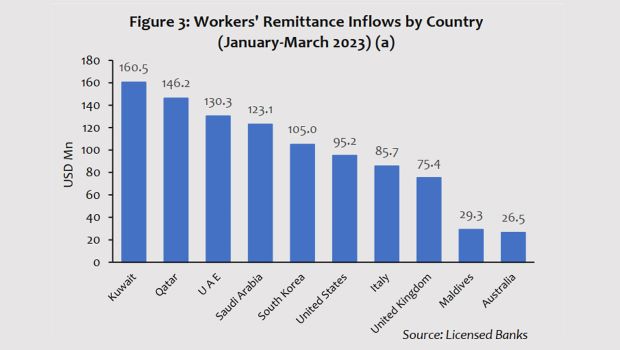COLOMBO – Sri Lanka has received 160.5 million US dollars of official remittances from Kuwait, followed by Qatar at 146.2 million US dollars and the UAE at 130.3 million US dollars in the first quarter of 2023, official data shows.
Workers in Saudi Arabia remitted 123.1 million US dollars, according to central bank data.
South Korea came in fifth place with 105 million US dollars in remittances.
Sri Lanka got 95.2 million dollars in remittances from the US, 85.7 million from Italy, 75.4 million from the UK.
More remittances came from Maldives in South Asia, that Australia. Sri Lankan worker remitted 29.3 million US dollars from Maldives and from Australia 26.5 million US dollars.
Maldives has the soundest money in South Asia, through a partially credible peg, without activist inflationism (macro-economic policy) to push growth and trigger currency collapses forcing people to flee to other countries.
Kuwait, Qatar, UAE and Saudi Arabia also has sound money through currency-board-like arrangements with high credibility.
South Korea use do have monetary instability and export workers to the Middle East and also to the US military at one time until the central bank was reformed for around the sixth time in the early 1980s helping the country reach monetary stability.
When Korea had monetary stability, manpower exports were promoted by the state to earn foreign exchange.
By the end of the 1980s, the wage gap between Korea and the Middle East had disappeared.
Sri Lanka also had monetary stability and imported labour until a central bank was created in 1950 on the basis of Harvard-Cambridge inflationism giving macro-economists to print money.
In the first decade of the setting up the central bank, as macro-economists printed money triggering forex shortages, restrictions on outward transactions began.
“The small improvement in the adverse balance on invisibles account in 1960 was mainly due to the substantial drop in private remittances and migrants’ transfers from Rs 85-4 million in 1958 and Rs 63-5 million in 1959 to Rs 38-6 million in 1960,” the central bank’s annual report said in 1960.
“The contraction in this item was the direct result of the successive measures taken in 1959 and 1960 to restrict such remittances.”
“A decline in the expenditures on foreign travel (as a result of tightening of exchange control on travel) …was another factor which contributed to the improvement on invisible account.”
Sri Lanka has severely restricted economic freedoms of the people in subsequent years to maintain the central bank and give monetary printing powers to macro-economists.
In 2022, the country defaulted under the worst macro-economy deployment in the history of the agency to target an output gap.
-economynext.com



Comments are closed, but trackbacks and pingbacks are open.